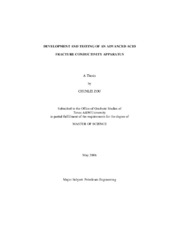| dc.description.abstract | Since the oil price has been stable at a high level, operators are trying to
maximize their production to get maximum return of investment. To achieve this
objective, all kinds of well stimulation technologies are applied to the proper candidate
wells. Acid fracturing is a standard practice to increase the production rate and to
improve ultimate recovery in carbonate reservoirs. There have been successful cases in
most carbonate reservoirs around the world. However acid fracture performance varied
significantly with the acid fluid type, pumping schedule, formation composition, rock
embedment strength, reservoir pressure, and other downhole conditions. Engineers have
tried to understand the acid transportation and dissolution mechanism and, wanted to
optimize each acid job design and to predict the acid treatment effect.
We made an acid fracture conductivity apparatus capable of conducting acid
fracturing experiments at conditions as close to the field treatment conditions as possible.
With reliable laboratory experimental results, engineers will understand the acid
fracturing mechanism and build a realistic model to improve the treatment design.
Our lab facility is customized for its tasks. The setup and experimental
procedures are optimized to make the operations feasible and the results accurate. The
fracture conductivity cell is per API standard and is modified to accommodate thick rock
samples. The thick rock will create a similar downhole leakoff condition when acid
flows across the fracture surface. The Chem/Meter pump is able to provide a pump rate
that matches field operational conditions. All necessary measurements are recorded.
The experimental data are processed and interpreted with statistics methodology.
Some preliminary acid fracture conductivity experiments were carried out. A few
different types of fluids are used to investigate the effects of acid concentration, fluid viscosity, and emulsification. All acid fluids had 15, 30 or 60 minutes contact time with
carbonate rocks. The acid leakoff velocity is controlled at velocity 0.003~0.01 ft/min to
simulate the downhole condition. Most of the experiments are successful. They can be
used to validate an acid fracture conductivity model. | en |


